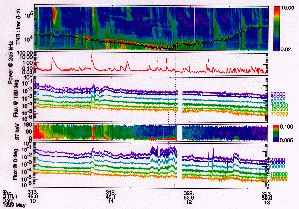
This science nugget tackles a topical subject: the case of remarkably (and thus far inexplicably) weak solar-wind flow highlighted in a recent media splash at the winter meeting of the American Geophysical Union. It also illustrates one of the true frontiers of our science, namely the frequently baffling manner in which the complex photospheric magnetic field reorganizes itself into the far different, and much simpler, heliospheric (solar-wind) field. Any Yohkoh image will show you the complexity of the field near the solar surface; by contrast the interplanetary field at the distance of the Earth normally has just two polarities, one each for the N and S ecliptic latitudes.
The solar wind mostly consists of open magnetic field lines, meaning that they stretch infinitely outwards (from the Sun) as a result of the fast flow of the solar wind and/or the weakness of the solar magnetic field. Yet why should some - or any specific fraction - of the solar surface field be "open" in this sense? Why does it not all close near the surface, as suggested by the existence of the "solar magnetic carpet", an earlier media splash.
Our tools for studying this situation include solar images and magnetograph observations of the field in the photosphere, plus theory, plus the tracking of high-energy particles that fly along the magnetic field and give us direct observations of some of its properties. We assemble some of this material in this nugget.
First, the solar wind:

This plot is exceedingly complicated, my apoligies for that; first just look at the solid line in the top panel. This shows the plasma frequency at the WIND spacecraft, a direct measure of the solar-wind particle density. It drops to a striking minimum just at the dotted lines (irrelevant here) on May 11, 1999, right in the middle of the "disappearing solar wind" interval. This plot does not show it, but the solar-wind speed drops during this interval too, and the two effects result in a strikingly low pressure striking the Earth's magnetosphere. This is really interesting, but we have to concentrate on the solar side of things, sorry!
The top panel also shows kilometer-wavelength spectra, time-resolved, and the fuzzy vertical traces reveal that disturbances are emerging from the Sun during these three days. The bottom three panels show energetic electrons observed by the WIND spacecraft - these electrons are streaming along the magnetic field line connecting to the Sun, and coincide with the radio bursts (top panel) as theory says they should. So, in a triumph of "electron telescopy", we are mapping out the interplanetary magnetic field right down to the source of the electrons in the low corona.
Now, let us look at the corona itself, courtesy of the Yohkoh SXT images:

This plot is exceedingly simple. It shows a large dim region to the west (rightward) of Sun center; this may be a large equatorial coronal hole, but only an official judgement by solar guru Karen Harvey would justify this. Nevertheless this region is at about the right location and time to emit a slow solar-wind stream, as observed May 10-12. If you have good Web bandwidth, you can check these data out in movie form, either a huge (1 MB) .gif file, or a large (120 kB) .mpg file.
To ask if this connection makes sense, let us turn to the only real tool we have for visualizing the solar magnetic field in the middle corona. This region is too tenuous for high-resolution imaging, although radio telescopes can in fact make images at times; it is too complicated for backwards extrapolations of solar-wind properties. Thus we are at the mercy of modeling based on the photospheric field. The so-called "source surface" models, originally invented by Altschuler and Newkirk, make use of month-long samples of photospheric magnetic fields (from the Wilcox Solar Observatory, in most cases), and approximates the coronal current systems by an artifical "source surface" at some arbitrary height above the photosphere. At this surface the field by hypothesis becomes radial ("open") and the solar wind flows freely. For this interval we find the following interesting things by using this admittedly crude model:

This shows how magnetic field lines extend outward from the Sun into the solar wind, and you can see where the magnetic fields close back down to the Sun and where they are open - click on the image above to see more details.
Was this really an unusual event? Apparently it was an extreme case of something that happens fairly often. Based upon the material presented above, which alas can't be the whole story (even at our present low level of understanding, the whole story would fill many pages!), we offer the following speculation: Perhaps we are looking at a fundamentally new kind of solar wind, neither the high-speed flow associated with the polar coronal holes, nor the low-speed flow associated with the heliospheric current sheet (streamer belt).
31 December 1999
H. Hudson (hudson@isass1.solar.isas.ac.jp)
D. Larson
J. Luhmann